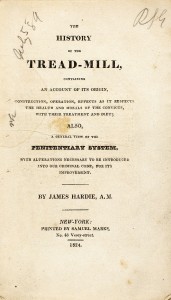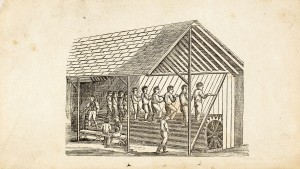Ever feel like running on a tread-mill is some kind of horrible punishment? Turns out, it is! According to a pamphlet titled The History of the Tread-Mill by James Hardie (1824), the tread-mill was first invented as a form of labor for prison inmates. The tread-mill had a dual purpose, in that it was used both as a way to prevent idle minds and bodies in prison, and was used to generate power or grind grain (hence the “mill” part of the word). According to the image from the pamphlet below, the original tread-mill more resembled our current day stairmaster.
The tread-mill was invented by William Cubitt in England in 1818, the first erected in the House of Corrections in London. Penitentiaries in the United States adopted the idea after hearing reports from the House of Corrections in 1822 that the presence of the tread-mill had “in every instance, proved highly useful, in decreasing the number of re-commitments, as many prisoners have been know to declare, that they would sooner undergo any species of privation than return to the house of correction, when once released.” That’s one powerful torture device!

When used in the United States, it was thought that the tread-mill would lead to moral reformation of the prisoners. Unfortunately, according to Hardie, all were “sadly disappointed.” While prisoners never experienced miraculous revelations of the evils of their ways while walking without really moving, the tread-mill did serve as a deterrent from returning to prison. Always looking for ways to prevent prisoners from having the time to “[indulge] in talking over their exploits in the paths of guilt” and “[suffer] to form new schemes for future execution”, the tread-mill certainly kept the prisoners busy, and made the idea of returning to prison far less appealing. Prison was a long, endless day at the gym, and who would ever want to return to that!
So next time you’re on a tread-mill thinking how torturous it is, remember you’re not alone. Hardie describes the act of being on a tread-mill as “constant and sufficiently severe; but it is its monotonous steadiness and not its severity, which constitutes its terror, and frequently, breaks down the obstinate spirit.” If prisoners from the 19th century could see us now, what would they think of our voluntary work outs on their prison provided forced labor machinery?


One thought on “The Torturous Tread-mill”